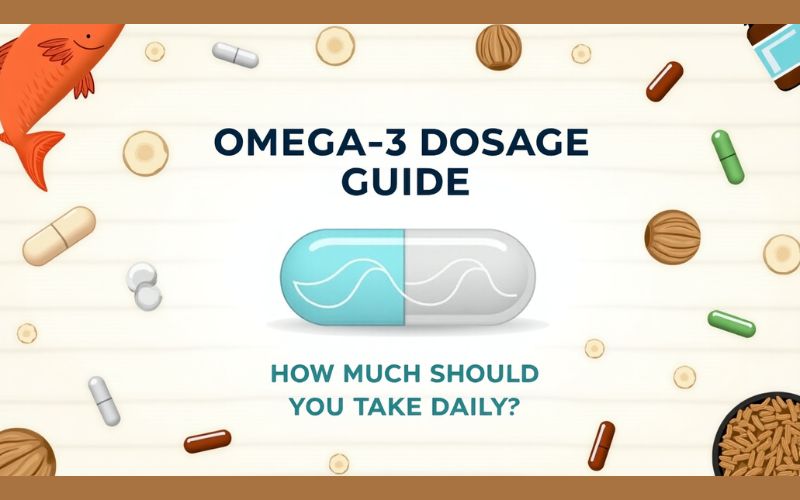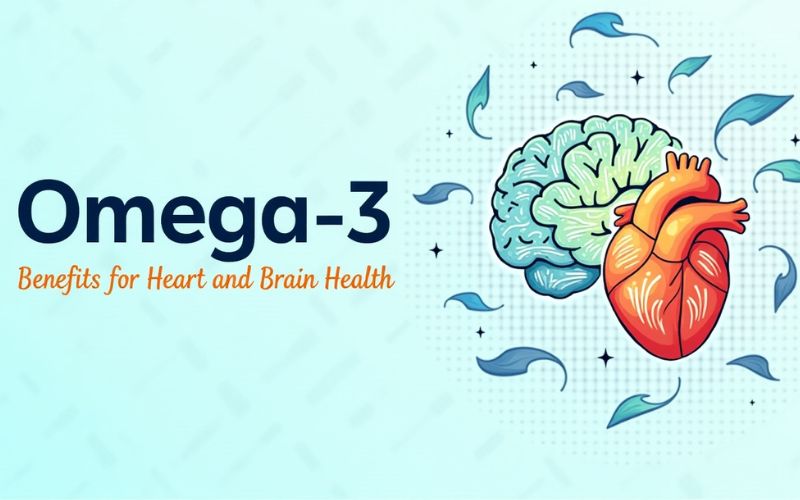Omega-3 fatty acids are essential for your health, yet many people aren’t sure how much they should be taking daily. Whether you’re trying to improve heart health, reduce inflammation, or support brain function, understanding the right omega-3 dosage is key. This Omega-3 Dosage Guide: How Much Should You Take Daily? will help clarify optimal intake based on different health goals while emphasizing safety and effectiveness.
Table of Contents
What Are Omega-3 Fatty Acids?
Omega-3s are polyunsaturated fats that play a vital role in your body’s cell functions. They’re primarily categorized into three types:
- EPA (Eicosapentaenoic Acid) – Known for reducing inflammation and supporting heart health.
- DHA (Docosahexaenoic Acid) – Crucial for brain development and cognitive performance.
- ALA (Alpha-linolenic Acid) – Found in plant sources like flaxseeds and chia seeds; it needs to be converted into EPA or DHA to be used effectively by the body.
Since your body cannot produce omega-3s on its own, it’s important to get them through diet or supplementation.
Why Dosage Matters
Getting the right amount of omega-3s is essential for achieving the intended health benefits without overdoing it. Under-consuming omega-3s may result in minimal health effects, while taking too much can lead to complications such as blood thinning or gastrointestinal discomfort.
This Omega-3 Dosage Guide: How Much Should You Take Daily? ensures you’re using omega-3s effectively and safely.
Recommended Omega-3 Dosage by Health Goal

The ideal omega-3 dosage varies based on your health goals.
General Wellness
For the average adult with no specific health concerns, a daily intake of 250–500 mg of combined EPA and DHA is generally recommended. This dosage supports overall wellness, including healthy cholesterol levels, cognitive clarity, and joint function.
Heart Health
People with a history of heart disease or high cholesterol may benefit from a higher dosage. The American Heart Association suggests consuming about 1,000 mg daily of EPA and DHA combined for cardiovascular support.
Brain Function and Mental Health
For supporting brain function and mental well-being, many experts recommend 1,000–2,000 mg daily. DHA is particularly important here, as it’s a primary structural component of the brain.
Studies also suggest this dosage range helps with mood disorders, focus, and age-related cognitive decline.
Inflammatory Conditions and Joint Support
Chronic inflammation and arthritis symptoms may improve with omega-3 dosages between 2,000–3,000 mg per day. At these levels, EPA plays a leading role in reducing inflammatory markers and easing joint stiffness.
However, this should be taken under medical guidance, especially if you’re on medication.
For Pregnant or Breastfeeding Women
Pregnant women are encouraged to consume at least 200–300 mg of DHA daily, as it’s crucial for fetal brain and eye development. Fish oil supplements that are purified and free from mercury are often recommended during pregnancy.
Can You Take Too Much Omega-3?
Yes. Like any supplement, balance is key. The FDA considers up to 3,000 mg of omega-3 from supplements per day safe for general consumption. Beyond that, there could be a risk of:
- Blood thinning
- Increased risk of bleeding
- Nausea or diarrhea
- Fishy aftertaste or bad breath
To stay within safe limits, always check your supplement label and factor in dietary sources like fish.
Best Practices for Omega-3 Supplementation
- Take it with food: Omega-3s are fat-soluble and are best absorbed with a meal that contains healthy fats.
- Check the EPA and DHA content: Some labels list total fish oil, not just the active ingredients. Look specifically for EPA and DHA levels.
- Choose high-quality supplements: Purity, sustainability, and third-party testing matter. Look for products that are IFOS-certified or carry other quality seals.
Omega-3 From Food vs Supplements

While omega-3s can be obtained through supplements, a food-first approach is often best. Great dietary sources include:
- Salmon
- Mackerel
- Sardines
- Flaxseeds
- Walnuts
- Chia seeds
If your diet is low in omega-3-rich foods, then supplements can be a convenient and effective way to bridge the gap.
Conclusion
This Omega-3 Dosage Guide: How Much Should You Take Daily? has shown that your optimal intake depends on your individual health needs. Whether you’re focused on heart health, cognitive performance, or reducing inflammation, omega-3s can be a powerful addition to your wellness routine.
Ready to support your health with omega-3 supplements?
Visit Nutritional World today to explore our curated range of high-quality omega-3 products. Our team is committed to helping you make informed and effective health choices—backed by trust, quality, and science.
FAQs
Q1: What’s the best time of day to take omega-3 supplements?
It’s best to take omega-3s with a meal that contains fat to improve absorption. Many people prefer taking them with breakfast or lunch.
Q2: Can children take omega-3 supplements?
Yes, in age-appropriate dosages. DHA is particularly beneficial for brain development in children. Pediatric guidance is advised.
Q3: Are plant-based omega-3 supplements effective?
Plant-based sources offer ALA, which converts poorly to EPA and DHA. Algae-based supplements provide direct DHA and are ideal for vegetarians and vegans.
Q4: How long does it take to see results from omega-3?
Some benefits, like reduced inflammation or improved mood, can be noticed within 4–6 weeks of consistent supplementation.


























